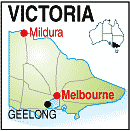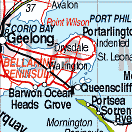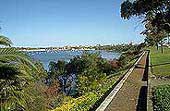|
Situated on Corio Bay, 75 km. west of Melbourne, Geelong is Victoria's
largest provincial city with a population of around 200,000.
The first European to set foot on the site of Geelong was Lieutenant Tuckey of the H.M.S. 'Calcutta'' in 1803. In 1824 explorers Hume and Hovell arrived at Corio Bay on their overland explorations from New South Wales and were told by aboriginals the site was known as 'Jillong', from which it takes its name. The first settlers in the area were J.A.Cowie and David Stead, who arrived in March, 1836. Others soon recognised the fertile hinterland of the bay, and enough had arrived by 1838 to justify its being gazetted as a town. By 1849 it had a population of 8,000 persons. John Batman, the co-founder of Melbourne, actually explored the area first as a potential site for Victoria's capital city. Many believed Geelong was a better site and, during the 1840's, much argument prevailed over which was the most suitable site for the administrative centre. With the discovery of gold in the region, particularly at Ballarat, some 85 km. north, the 1850's saw rapid growth and Geelong boomed as the nearest transport and supply centre to the goldfields. When the gold ran out in the 1860's, Geelong stagnated for some 40 years until the 20th. century industrial boom saw it expand to again rival Melbourne. It became the hub of a flourishing wool and wheat industry. Several woollen mills were established and after World War 1, diversification of industry saw the establishing of fertiliser and phosphate plants, the Ford Motor Co., and Corio Whiskey. After World War 11, the Shell Oil Co., Alcoa of Australia, and many other major industries established in Geelong and its prosperity was assured. A grain elevator, the largest in Australia, was set up at Corio Quay in 1940 to handle increasing rural production. The Port of Geelong has always been a busy one. In 1854, 438 ships arrived in the area. Today there are 21 wharves which despatch agricultural and industrial products to national and international markets. Yet, Geelong is not merely a prosperous manufacturing area. The growth of tourism through the 70's, 80's and 90's, has encouraged a review of the city's rich heritage. Some 200 National Trust classifications have been listed in the city, and its proximity to the beautiful Bellarine Peninsula and the Great Ocean Road, have made it a popular holiday centre for visitors. The establishing of a National Wool Museum, a Maritime Museum and a growing wine industry have enhanced its popularity enormously. It is within an hour of several national parks and there are some of Australia's best golf courses in and around the city. There is so much to see and do around Geelong it will require a few days to explore and enjoy. There are two information centres and a list of accommodation houses, and places to visit, will be found below. PLACES OF INTEREST:
| ||||||||
INFORMATION CENTRE:
National Wool Museum
Moorabool St. Geelong
Ph: 03 5226 4660
GEELONG - CORIO
Geelong Information Centre
Princes Hwy, Corio
Ph: 03 5275 5797 ph: 1800 620 888
Email: gotvic@geelongcity.vic.gov.au
HOW TO GET THERE:
There is a small airport south of Geelong on The Torquay Road. Geelong is less than an hour from Melbourne by coach, rail or car, VLine operate trains from Melbourne to Warrnambool .
Coach Operators

 |
© Copyright Peter W. Wilkins | |



